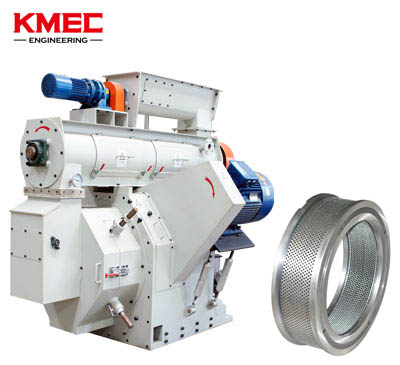Chinese and Southeast Asian Pellet Market and Development
Biomass Pellet Fuel Production and Consumption of China
The wood pellet market in China is still in its infancy, and very little coherent information was found on current wood pellet production, consumption and markets. Pöyry (2011) reported that China was the biggest consumer of pellets by 2010, (around 600,000 tons). However, 85%of these pellets were based on agricultural residues which differed significantly from wood pellets, both in term of fuel properties and market characteristics. According to the Bioenergy International wood pellet map 2011 (BI, 2011), there were 19 (wood) pellet mills in China, all close to the Eastern coast. Capacities ranged between 12,000 and 120,000; total reported capacity is 750 kilotons per year. The two pellet plants with capacities >= 100 kilotons are in Xianhu, Shenyang, Liaoning (100 kilotons/yr) and Huafeng agricultural biotechnology, Yangzhong, Jiangsu (120 kilotons/yr). The anecdotal data found in literature is summarized below:
Shen (2010) reported on a company in Zhejiang province (a few hours drive from Shanghai) utilizing bamboo sawdust to produce pellets–production in 2010 was reported to be 10,000 tons. China’s largest bioenergy company Drag Power, led by Kai Johan has so far not published any plans to build wood pellet pants in China.

Indonesian and Malaysian Pellet Fuel Development
Also in Indonesia, reports are extremely scarce. Bioenergy International reports on one wood pellet plant of 100 kilotons capacity on the Indonesian part of Papua New Guinee of 100 kilotons (BI, 2011). Furthermore, in September 2010, the company Solar Park Indonesia reported that they have built a wood pellet plant situated on Java of 80 kilotons capacity, using sawdust from tropical hardwood, and focused 100% on export to the EU, Japan and Korea (Park, 2010). However, over the past few years, wood pellet production lines have been established at a speedy pace. Thanks to the abundant wood resources in the Kingdom of Islands, the country is heading its way to becoming one of pellet fuel production bases and animal feed processing bases. Speaking of investors, not only domestic investors and the local keep an eye on the booming pellet production industry, but also foreign businessmen from South Korea and Japan attach importance to the material-oriented huge market. Indonesia and Malaysia attract East Asian businessmen to invest in the tropical region filled with biomass raw materials. In Malaysia, palm oil industry boasts a pillar sector within oil extracting and refining industry. Due to the palm use, palm EFB can be further processed into biomass pellets, therefore the palm material can be comprehensively applied in a sustained manner. According to statistics of our sealed deals, a large proportion came from the southeast region including the two brisk markets, Indonesia and Malaysia.
READ: JAPANESE PELLET MARKET
READ: SOUTH KOREAN PELLET DEVELOPMENT
Vietnamese Pellet Development
With a large and rapidly expanding timber industry, Vietnam could potentially become an important wood pellet producer – the total technical potential of sawdust was estimated to be 5.8 million tons, of which the largest part is located in the western Highlands (2.5 million tons) and central Vietnam (1.15 million tons) (Phuong, 2011). Vietnam has not been a large internationally-oriented wood pellet producer, although in 2009 and 2010, small-scale wood pellet exports were observed to Korea and Japan (see pervious sections). Total production capacity of the large wood pellet plants was reported to be between 120 and 140 kilotons, although it is unclear how much actual production was realized. Beside these companies, there are many small pellet mills supplying biomass pellets for local demands. However, due to lack of available information about these pellet mills, they cannot be listed accurately. But there are several large producers of rice husk pellet production plants dotted in the country.

Read:How to start a pellet plant
Thailand Biomass Pellet Development
The situation in Thailand seems like that of Vietnam. Biomass pellet production is an emerging business but booming dramatically. Thailand has seen over the past few years a big increase in biomass pellet production nationwide. We also have business connections with clients from Thailand for establisment of biomass pellet plants. Thailand is also a country full of biomass material, such as wood material and agro waste, because Thailand has the capacity of producing rice and paddy in the agricultural sector. Agro waste from the rice production industry makes a good contribution to the comprehensive utilization of agro residue. Apart from the large number of agro waste production, wood resources are also richly seen over there.
-------------------------------------------------------------------------------------------------------------------------------------------------------
News
- Small Pellet Machine Manufacturer-Kingman
- Application of Wood Pellets and Use of Biomass Pellets
- From Fossil Fuel into Biomass Pellet Fuel
- Biomass Pellet Making Machines Market
- Applying of pellet stoves for home use
- Highland pellets to build $130 million facility in arkansas
- How to deal with the blocked hammer mill
- How to Make Wood Pellets with Sawdust
- The government policy promotes the development of biomass fuel
- Market analysis of biomass pellet fuel
- Strategic positioning of renewable energy
- Biomass energy has pass through the pre assessment
- The key point of deep processing of biomass pellet
- Harbin is promoting the development of biomass machinery
- The development of biomass formation technology I
- The development of biomass formation technology II
- Biomass energy industry is now going full tilt in 2015
- Rapid increasing demand of sawdust pellet on the market
- Pellet fuel market in EU
- Chinese Biomass Energy Conference held in Beijing
- Future market development of straw pellet mill
- Peanut Shell Pellet Mill Makes High Quality Pellets
- The utilization of straw is only 5%, biomass energy needs our attention!
- Corn straw pellet machine relieves the tight supply of fuel energy
- Reasons for loose or not forming of biomass pellet mill





